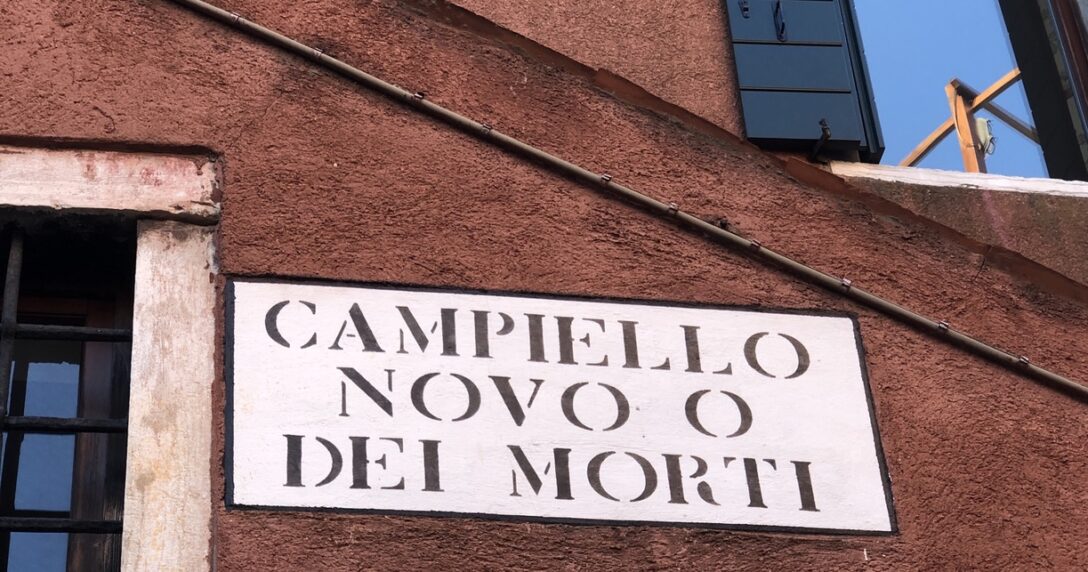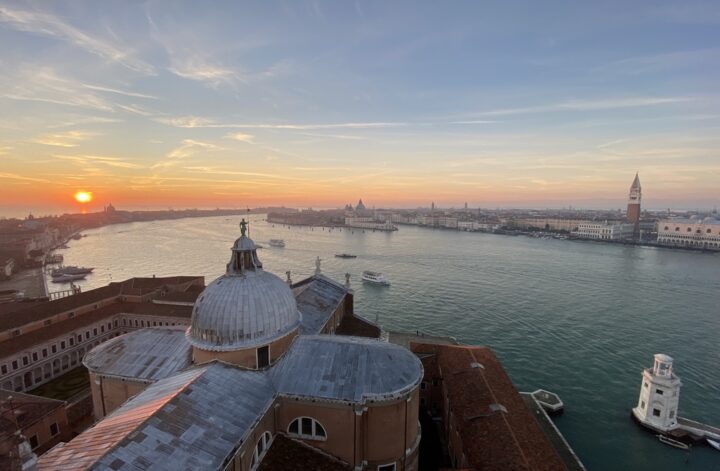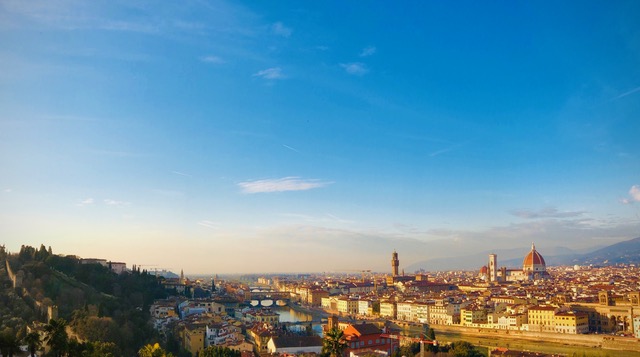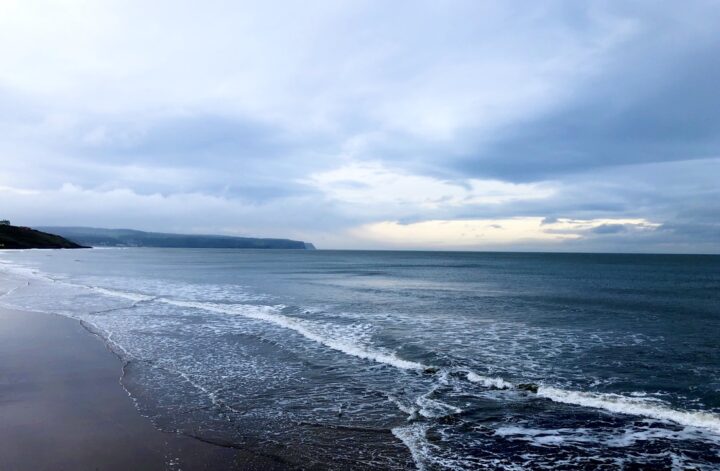I’ve always been afraid to visit Venice. A city famed for the grace and reserve of a Bellini madonna is easily ravished. I feared the city of mirrors, masks, dreams, would prove to be nothing more.
Venice is known for forming her streets out of the ‘trackless’ sea rather than the scarred, limited land – endless streets for the imagination.
I thought the image of my imagination would be replaced by cruise-ships, ice-cream tubs turning on the water, heat rising from every stone and from swarms of shouting countrymen fighting their corners with selfie-sticks. My dream would be shattered forever.
It wasn’t.
We arrived after dark. At first I felt we might have been in any European city as we passed from the carpark into a tree-lined square, freezing air snatching at our breath. There were few streetlamps in the narrow ‘calle’, but the more major streets were decorated with fairy lights. This was the 6th of January, when local children open their Christmas presents (brought by la Befana on her broomstick).
Then the first dead end, a drop into black silent water. Impossible four-leaved-trefoils gleamed above every window.
Our house in the Castello district should have been less than 20 minutes’ walk away, but the city, which was once wary of strangers, is a labyrinth. We were soon lost in a web of deserted sotoporteghi, most of which led deliciously to unexpected spilt-ink canals.
It was more than an hour before we passed under an archway decorated by a moon pale Misericordia – the maddona’s outstretched cloak of mercy falling like slack-tide waves – onto the Calle del Paradiso.
Our house stood at a watery crossroads by the bridge of paradise.
The mornings of the holiday are the mosaic pieces of memory that still dazzle before my eyes even when I don’t mean them to.
My breath blooming into the air, and the footprintless crossroads blue as lapis under the cold sky. So cold I dived back into the house to seize two scarfs of soft grey fur and zipped them down quickly beneath my coat before the warmth escaped.
I never realised icy air could be so sensual.
Crossroads always hold possibilities; streets bending out of sight tug at the heart. So does the sea. But I’d never felt anything like the tug of these blue streets of the sea, beckoning as though they led directly to the four corners of the Stato de Mar.
The streets, both of water and paving stones, were empty.
As we neared the Piazza San Marco we were no longer alone, but I was astonished by the quietness of even the Bridge of Sighs and the Rialto. I was allowed to stand without a jostle and look across at the Grand Canal to where the Palazzo Dogal, the campanile…all of it…lay in the light of a Canaletto. The air glittered, every detail bright as with the finest brushstrokes, but pearled with the hint of a sea mist.
The Piazza San Marco was almost empty as we first arrived. Even past midday it was no more crowded than any city square:

It was busier inside the church, but not so busy that we could not watch its golden vastness gleam and echo like the sea-cave only just abandoned by the tide.
Towards two o’ clock crowds arrived, and we left to explore more secret corners of the city.
It is these that form the rest of my glinting mosaic snatches of memory.
The Scala del Bovolo (of the snail), like the staircase to heaven, corkscrewing through time against the blue. Towers, a medieval symbol of personal pride and strength, were forbidden in the Serene Republic, so Piero Contarini built a staircase for the view, wide windows revealing the twist of fate within to demonstrate it is indeed as fragile as a snail’s shell, no threat to the citizens.

The street names:


These seemed pearls of the imagination which would have to prove sham. But though illusions are plenty in Venice, they are never hiding the ordinary. With a quick google, I find a medieval account explaining that in the 12th century this street was indeed the hotspot for assassinations. Underneath the Campiello Novo o dei Morti lie the bones of victims of the 1630 plague, as well as the skeleton of a famed corsair.
The Serenissima is seductive, like a female courtier behind a black velvet Muretta mask (known as the ‘muta’, because the wearer had to hold the button in her mouth to stop it falling from her face.) The eyes move bright behind the dark slits and wink at you occasionally.



Venice must have been called a fairytale city a thousand times. But she is fairytale in a very particular sense; walking these streets, I have the feeling almost of being tried and tested as in an enchanted quest, navigating through a luxuriance of illusions and riddles.
The sea fog – caigo – closing in with the evening, and the gates of the great Arsenale, deadly secret womb of the Stato de Mar – as Venice’s empire was called.
The bricks were as tender as the breast of the sunset sky, but I shivered in the blank wet air at the facelessness of the Serene Republic’s power; war conducted with such grace and efficiency.
Huge marble lions with strangely sad, kind eyes rested on their paws beneath the walls.
Here they built a galley a day, swift as seabirds to wing their way over an ocean that was one great street to lead wherever they wanted — turning homeward loaded with sharp spices and the most priceless jewels of imagination from over the edge of the map. There were sailors on board those galleys to whom Venice was a home. I wondered what it could possibly feel like not to be a stranger here.

The cemetery island was what I have always expected of an afterlife, the ‘soundless cypress’ beckoning softly from across the mother-of-pearl sea
“Here, where the world is quiet;
Here, where all trouble seems
Dead winds’ and spent waves’ riot
In doubtful dreams of dreams”

The domes glimmer gray-green in an under-the-wave light as dusk slides over the city. And after dark, Venice is frail, melting into the mist. There’s nothing dead about it, but it seems far too pale for life. Like a bubble of glass blown from smoothest silver sand.
Remembering the cruel serenity of the Arsenale, I was continually startled by the love in the pale friezes rising above so many calle. The unmasked human faces.

I’ve never felt anything like the comfort of plunging from the dark tangled sotophoregi into the warmth of a bacaro crowded with welcoming bodies, gleaming copper pans hanging from the low ceiling. The bacaro are little Venetian wine-bars, many dating from the 14th century, which serve little cheap glasses of sparkling red local wines ‘ombre’ and snacks called cicheti – crazy seafood straight from the lagoon. (You can read my poem about them here).

We spent our evenings flitting from one to another, lost in the cold between stops just long enough to enjoy the bursting heat gently un-numbing my fingers and then rushing to my face so that I tore off my layers of scarves like a creature shedding winter fur.
On the last day but one we explored the lagoon on the vaparetto. I was amazed at the sight of the further islands, snatches of homelike countryside with patchwork quilts of fields, lost on this big silver mist-threaded water like spots of realism adrift on a dream. Here and there, a palazzo or a church, standing alone with the waves trying to climb its marble flights.
We stopped to picnic on a quiet island of cypresses, bare bushes and little low cottages, and then turned back to the city. The last stop before our house was San Giorgio Maggiore, and from the bell-tower the Serenissmia spread out before us, ‘throned on her hundred isles’.

In spite of the bright skies winging over the city, throughout our visit the sea mist never quite melted away. The Serenissima did not drop her veil. Instead, as the days drew on the white caigo thickened.

On the last day, fog drifted over every canal, the domes capped like mountains and the water opaque as a mirror pearled with age.
Laden with luggage we stumbled through the webbing calle – blind, but certain that every palazzo watched us, clear-eyed in the fog of dreams. I am used to leaving a place I have loved with some sense of ownership. But this pearl-of-the-sea city with her streets free of footsteps can never be known, let alone possessed. I still can’t imagine what lies at her heart, what all these mirror images and enchantments were woven to protect.
I am left with a sense of paradox. I had thought a dream could never be inhabited in the flesh, the air cold and alive, sudden warmth of the bacaro rushing to my face like reality. I have lived it, and yet it still retains the gleaming unlikeliness, the wild perfection of the unreachable.




2 Comments
To wander and discover and lose oneself: these are the pleasures of any new city, but in Venice where every crossing of ways reveals competing views of the enticing unknown you are accompanied by a ghostly companion of nostalgia, knowing you will never find again that meeting of ways and never enter the vision not taken. To wake in Venice to bells ringing is to wake and find yourself—as you said so well—inside a dream.
Yes! You have so gracefully expressed the elusive phenomenon that seemed just on the edge of my tongue throughout my writing the blog post. The vision not taken…that is at the heart of Venice. I just checked out the EdRLS blog by the way and the mine of information on there fascinating – coincidently I’m very Stevenson obsessed. Especially enjoyed your post on his reaction to Sensations d’Italie. Where did you come across my blog by the way? I haven’t publicised it at all yet and am quite surprised anyone should happen on it.